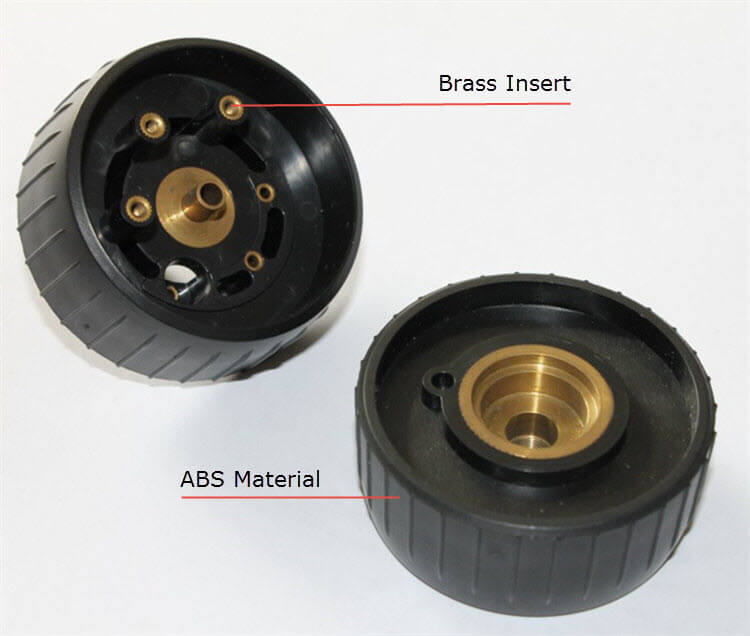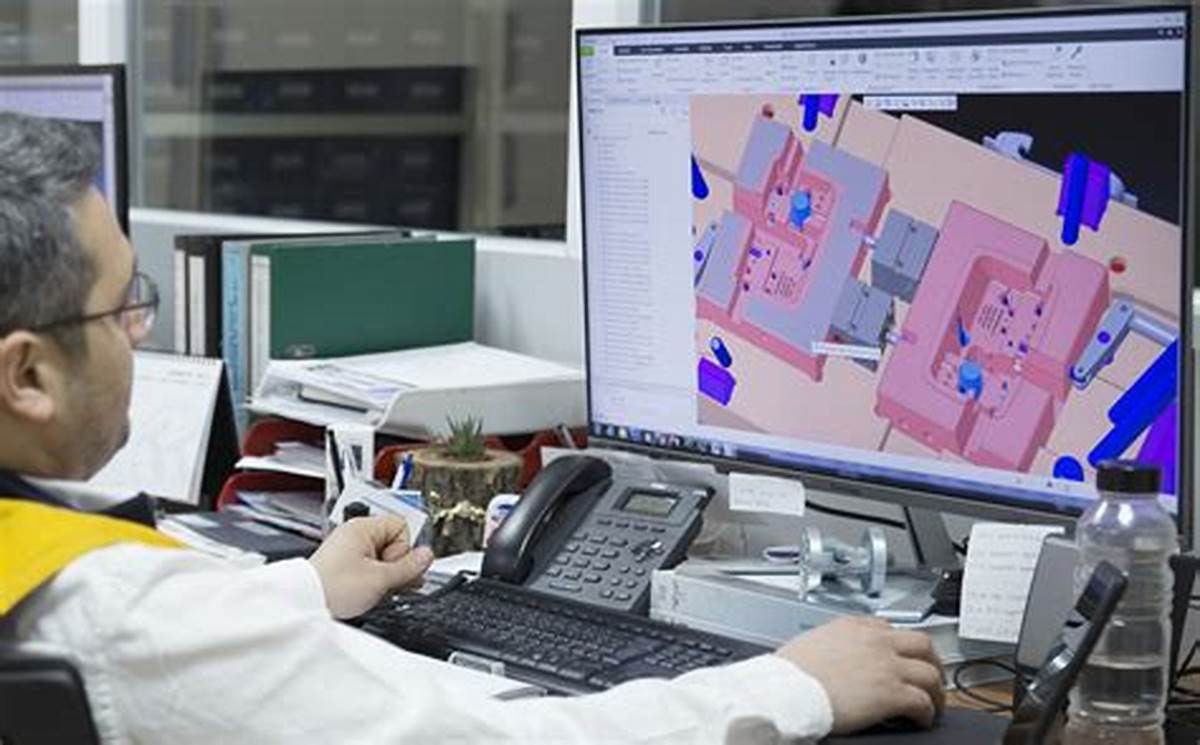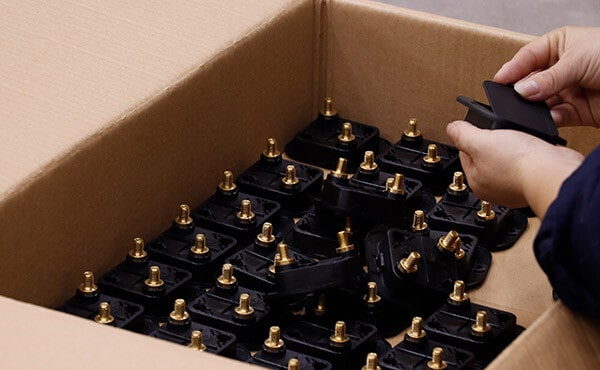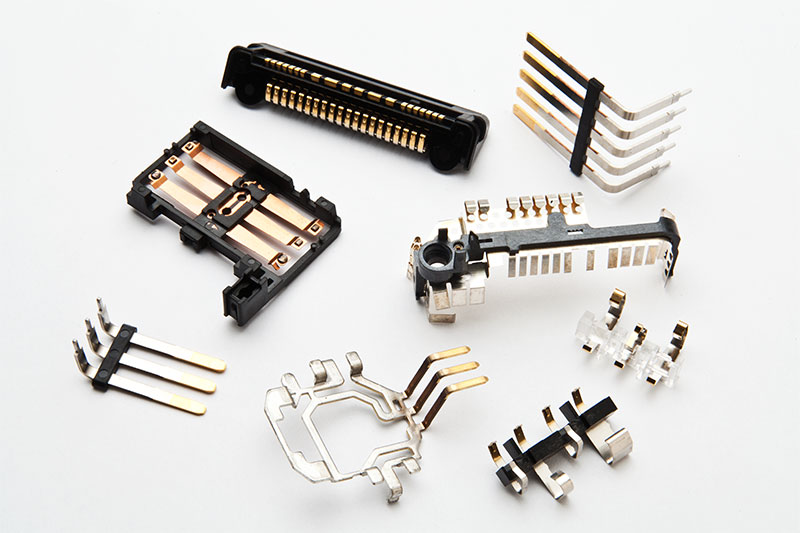Insert molding, a revolutionary manufacturing technique, ingeniously combines metal and plastic into robust, durable components, revolutionizing industries like aerospace, automotive, and medical devices. This process, evolving from traditional injection molding, offers a streamlined, cost-effective approach to producing high-quality parts. Team MFG's advancements in automated insertion further enhance efficiency, making insert molding a game-changer in creating resilient, functional, and economically viable products for a range of applications.
The Process of Insert Molding
Fundamentals and Basic Principles of Insert Molding
Insert molding is a process where metal inserts are placed into a mold, and then thermoplastics or other materials are injected around them. This creates a single piece with the insert encapsulated by the plastic. The result? A strong mechanical bond and often, chemical bonding too. This technique is key in industries like aerospace, automotive, and medical devices.

Step-by-Step Guide to the Insert Molding Process
Design for Manufacturability: First, we plan. We think about the end product and how it should work. We choose materials for strength enhancement and design flexibility.
Mold Tooling: Next, we make the mold. This is a big deal because the mold decides the shape and size of the finished product.
Insert Placement: Now, we place the inserts. This could be manual or automated. Each has its own benefits.
Injection Molding: We then inject molten plastic into the mold. This plastic surrounds the insert.
Cooling and Solidification: The plastic cools down and becomes solid. The metal insert and the plastic become one piece.
Ejection: Last, we take the finished product out of the mold.
Key Components, Materials, and Equipment Used
● Metal Inserts: Often made of brass or stainless steel for corrosion resistance.
● Thermoplastics: These are plastics that melt and solidify when heated and cooled.
● Injection Molding Machine: This is the machine that heats up the plastic and injects it into the mold.
● Mold: A custom-made tool that gives the plastic its shape.
Automation vs. Manual Insertion: Pros and Cons
Automated Insertion:
● Pros: Fast, good for big production volume, and very reliable.
● Cons: Can be costly to set up and may not work for complex designs.
Manual Insertion:
● Pros: More control and can handle complex insert molding designs.
● Cons: Slower and may not be as consistent.
Insert molding makes products better in many ways. It's used in consumer electronics, defense, and more. The process can add wear resistance and tensile strength. It also makes manufacturing easier by reducing post-molding assembly costs.
When we choose materials, we think about the product's use. We want materials that last and do their job well. We also look at cost-effectiveness and if the material is eco-friendly.
Design and Technical Considerations
Mold Design, Insert Positioning, and Key Design Guidelines
When we talk about insert molding, we're looking at a process where metal inserts are placed into a mold, and then thermoplastics are injected around them. The mold design is super important. It's like a blueprint for your project. You need to think about where to put these metal parts so that when the plastic goes in, everything fits just right.

Here's a quick list of things to keep in mind:
● Inserts should sit tight without moving.
● The mold must open and close easily.
● There should be enough space for plastic to flow around the inserts.
Importance of Material Selection and Compatibility
Choosing the right materials is like picking a team for a group project. You want everyone to work well together. For insert molding, you need to match metals with plastics that stick to each other when they cool down. This can mean combining thermoplastics with metals that have good corrosion resistance or using engineering plastics for better wear resistance.
Remember these points:
● Some materials are friends and stick together well.
● Others don't mix and can cause the part to break.
● The right combo means your part will be strong and last a long time.
Overcoming Common Challenges and Technical Limitations
Not everything is easy in insert molding. Sometimes, things can go wrong. But don't worry, we can fix most problems. For example, if the metal inserts are not placed correctly, the plastic won't cover them the right way. Or if the wall thickness is not even, some parts might be weak.
Here are a few tips to tackle these issues:
● Use advanced quality equipment to place inserts perfectly.
● Do a cost analysis to see if automated insertion is better than manual insertion.
● Check your mold tooling often to make sure it's in top shape.
By keeping these things in check, you can make parts for cars (automotive), planes (aerospace), phones (consumer electronics), and even medical devices. It's all about making sure you've got the design down, the materials matched up, and a plan to beat any challenge that comes your way.
Applications and Industry Use Cases
Insert Molding in Automotive, Aerospace, Medical, and Consumer Electronics
Insert molding has become a key process in many industries. Let's look at how it's used:
● Automotive: Here, insert molding is all about making parts stronger and more durable. Think of metal inserts in car interiors or electronic sensors. They need to be tough to last a long time.
● Aerospace: In planes, everything must be light but strong. Insert molding helps by combining thermoplastics with metal parts. This can be for things like seat buckles or small engine components.
● Medical devices: Cleanliness and safety are super important. So, medical devices use insert molding to put together parts without gaps where germs could hide.
● Consumer electronics: Phones and gadgets need parts that fit just right. Insert molding helps make parts like battery connectors and button assemblies.
Other Industrial and Commercial Applications
Many other places use insert molding too:
● Defense: Military gear needs to be tough. Insert molding makes parts that can take a beating.
● Industrial machines: Big machines have lots of parts. Insert molding helps make them quickly and keeps them working smoothly.
Case Studies: Successful Insert Molding Projects
Let's talk about some real stories where insert molding did great things:

Car Parts: A car company used automated insertion to make door handles. They got parts out faster and saved money.
Airplane Seats: An airplane maker used vertical injection molding to make seat parts. They were lighter, which meant the plane used less fuel.
Medical Tools: A medical tool had tiny metal inserts put in with manual insertion. It made the tools really reliable, which is super important for doctors.
Advantages and Benefits of Insert Molding
Enhanced Strength, Durability, and Design Flexibility
Insert molding is a process that combines metal and plastic into one unit. This makes products stronger and more durable. Think about how metal is tough and plastic is flexible. When we put them together, we get the best of both worlds. For example, in consumer electronics, a metal insert in a plastic casing can protect the device from damage.
This method also gives us lots of design flexibility. We can make complex shapes that would be hard to do with just metal or plastic alone. In aerospace or medical devices, this means we can create parts that fit perfectly where they need to go.
Cost-Effectiveness, Efficiency, and Time Savings
Insert molding is a smart way to save money and time. It combines steps into one. Instead of making a metal part and a plastic part and then putting them together, we do it all at once. This is what we call process optimization. It means we use less time, and time is money, right?
We also save on mold tooling costs. With automated insertion, we can make a lot of parts fast. This is great for when we need many pieces, like in automotive manufacturing.
Reduction in Assembly and Labor Costs
One of the best things about insert molding is cutting down on assembly costs. Imagine having fewer steps to put something together. That's fewer chances for mistakes and less time spent on work. Manual insertion can be slow and costly, but with insert molding, the metal inserts are put into the mold before the plastic goes in. So, when the part comes out, it's all done!
This means we need fewer people to put things together, which saves on labor costs. In industries like defense or automotive, where every penny counts, this is a big deal.
In short, insert molding is a really useful way to make parts for all sorts of things. It's strong, it saves money, and it makes making things simpler. Whether it's for cars, planes, or even your phone, this process helps make the parts that keep our world moving.
Pre-Process Considerations and Production Aspects
Types of Inserts and Their Selection Criteria
When we talk about insert molding, we're looking at a process where metal inserts or other materials are combined with thermoplastics to create a single, unified part. The types of inserts can vary, from threaded inserts used in automotive parts to electrical connectors in consumer electronics. The key is to choose inserts based on:

● Material compatibility: The insert should bond well with the plastic. For example, brass inserts are often used for their corrosion resistance.
● Strength requirements: Some applications, like in aerospace or defense, need high tensile strength. Here, steel inserts might be chosen.
● Design needs: Some designs require design flexibility. Engineering plastics can offer this adaptability.
Choosing the Right Machine and Process Parameters
Selecting the appropriate machinery is vital for cost-effectiveness and reliability. Vertical injection molding machines are commonly used for insert molding because they allow for automated insertion. When setting up the machine, consider these factors:
● Mold design: It needs to accommodate the insert securely.
● Material selection: The plastic used should enhance the strength and wear resistance of the final product.
● Process optimization: Adjusting process parameters like temperature and pressure can help avoid defects.
Quality Control Measures and Ensuring Durability in Final Products
Quality control is non-negotiable in insert molding, especially for medical devices and industrial applications. Here's how durability is ensured:
● Advanced quality equipment: This includes using sensors and cameras to check the alignment of inserts.
● Material tests: Conducting tests for material selection helps predict how the insert and plastic will behave together.
● Post-molding assembly checks: Inspecting the mechanical bond and chemical bonding after molding ensures that the insert is properly encapsulated without weakening the wall thickness.
Economic and Environmental Considerations
Cost Analysis: Investment, ROI, and Time Efficiency
When we talk about insert molding, we're looking at a process that can save us time and money. The upfront cost includes mold design and mold tooling. These can be pricey, but they're a one-time investment. Over time, the costs go down because we reuse the molds.
Automated insertion is faster than manual insertion. It means we can make more parts in less time. This is called time efficiency. Companies that make things like medical devices or consumer electronics often use insert molding. They do this because it can handle high production volume. This means a better return on investment (ROI).
Environmental Impacts, Sustainability, and Eco-Friendly Materials
Now, let's talk about the planet. Insert molding can be kinder to the environment. How? Well, it can use eco-friendly materials like engineering plastics. These are better than some other materials because they can be recycled.
The process also cuts down on waste. We can use thermoplastics that melt without burning. This means we can use them again. Plus, insert molding makes stronger parts with good wear resistance and tensile strength. Stronger parts don't break as easily, so we don't throw away as much.
Some insert molding materials are thermosets and elastomers. These are often used in aerospace and automotive stuff. They're tough and can stand up to a lot. They also help with corrosion resistance. This means things like cars and planes last longer.
To sum it up, insert molding helps us make things quickly and for less money. It's also a choice that can be better for our world. We use strong materials that last and can be used again, which is great for our Earth.
Challenges, Limitations, and Solutions
Common Problems, Troubleshooting, and Advanced Optimization Techniques
When it comes to insert molding, we often face a few hiccups. One common problem is metal inserts not fitting well. This can cause weak bonds. To fix this, we check the mold design and make sure everything is snug. Sometimes, thermoplastics don't flow right. We need to tweak the machine settings for this. It's all about finding the sweet spot.
● Troubleshooting Tip: If the insert shifts, pause and check the automated insertion or manual insertion setup. Adjust if needed.
● Optimization Technique: Use advanced quality equipment to test the tensile strength and wear resistance. This helps us make parts that last.
Material Constraints and Environmental Factors
Materials can be tricky. Some engineering plastics are tough but not all can handle heat or cold. We pick materials based on where the part will be used. For example, in aerospace, materials need to resist extreme conditions. Eco-friendly materials are also big now. We want to do good for the planet while making strong parts.
● Fact: Thermosets and elastomers offer good corrosion resistance. This is key for parts that face harsh chemicals.
Team MFG: A Case Study in Excellence
Let's talk about Team MFG. They're stars in insert molding. They worked on parts for medical devices. They used CNC machining to make precise mold tooling. Their vertical injection molding was spot on. They even found a way to improve mechanical bond through chemical bonding.
● Case Study Highlight: Team MFG reduced wall thickness without losing strength. This saved material and money.
● Quote from Team MFG: "We aim for design for manufacturability. It means making parts easy to produce without wasting resources."
In insert molding, we think about making things better, stronger, and more cost-effective. We look at material selection and process optimization. We want to make parts that work well in industrial applications and commercial uses. It's about making sure things fit right, last long, and do their job well.
Future Trends and Developments in Insert Molding
Emerging Technologies and Innovations in Insert Molding
Recent years have seen emerging technologies revolutionize insert molding. Automated insertion is becoming more common. This means machines are placing metal inserts into molds. It's faster than manual insertion. Also, 3D printing is shaking things up. It allows for complex mold design that wasn't possible before. This is great for cost-effectiveness.
● Robotic systems are now handling inserts, which leads to fewer errors.
● 3D printed molds can be made quickly and changed easily.
Market Trends, Industry Predictions, and Potential New Applications
The market is always changing. Here's what's happening:
● Medical devices and consumer electronics are using more insert molding.
● Aerospace, automotive, and defense are looking for strength enhancement and design flexibility.
● Experts think the demand for eco-friendly materials will grow.
One study shows that by 2025, the insert molding market could be much bigger. This means more industrial applications and commercial uses.
Technological Advancements and Trends in Material Science
Materials are getting better. We have engineering plastics with more wear resistance and tensile strength. Thermoplastics, thermosets, and elastomers are all improving. This helps with process optimization and material selection.
● Polymer technologies are creating plastics that last longer.
● Eco-friendly materials are being developed for a greener process.
Insert molding is moving forward fast. We're seeing advanced quality equipment and better polymer technologies. This makes insert molding considerations important for any project. Insert injection molding is blending plastic-metal combination better than ever. This means more reliability and corrosion resistance. The insert molding process is becoming more refined, with better insert molding applications. Insert molding design and insert molding techniques are also advancing. This is changing the plastic molding process. Insert molding materials are now more diverse. People often compare insert molding vs overmolding. But each has its place. Plastic injection inserts are key for many products. And with insert molding capabilities growing, we can expect more insert encapsulation in the future.
Conclusion
Insert molding, a transformative manufacturing technique, skillfully merges metal and plastic, enhancing the durability and functionality of products in industries like aerospace, automotive, and medical devices. This process, an evolution of traditional injection molding, involves placing metal inserts into a mold, followed by the injection of thermoplastics, creating a strong, unified component. Key steps include design planning, mold tooling, insert placement, and injection molding, culminating in a product that exemplifies strength and design precision. With both automated and manual insertion methods, insert molding offers versatility and efficiency, making it a preferred choice for diverse applications, from consumer electronics to defense. This method not only streamlines production but also emphasizes eco-friendliness and cost-effectiveness, positioning it as a future-forward solution in modern manufacturing.
FAQ
Q: What exactly is insert molding in the manufacturing process?
A: Insert molding is a manufacturing technique that involves encapsulating a pre-formed component, often made of metal or another material, with thermoplastic or thermosetting plastic materials during the injection molding process. The pre-formed component, known as the insert, can be a simple metal stamping or a complex assembly of parts. The process begins with placing the insert into the molding machine, where it is held in place with either magnets or mechanical means. Molten plastic is then injected around the insert, forming a single integrated piece upon cooling and solidification. This method is highly efficient for creating parts with embedded components or reinforced structures.
Q: How does insert molding differ from traditional injection molding?
A: The primary difference between insert molding and traditional injection molding lies in the presence of an additional component within the mold during the molding process. In traditional injection molding, a mold is filled solely with molten plastic, which then cools and solidifies to form the final part. In contrast, insert molding involves placing an insert, typically made of a different material like metal or a different plastic, into the mold before the injection of the molten plastic. This allows the plastic to form around the insert, creating a bond and integrating the two materials into a single piece. Insert molding can thus add strength, functionality, or conductivity to the final product that is not achievable with standard injection molding alone.
Q: Can you list the primary materials compatible with the insert molding process?
A: The insert molding process is versatile and can accommodate a variety of materials for both the inserts and the plastic resin. Common insert materials include metals such as brass, stainless steel, and aluminum, which can provide structural strength or electrical conductivity. Plastics like polycarbonate, nylon, and ABS are also used as inserts when a different type of plastic or a dissimilar material property is desired in the final part. For the molten material that encapsulates the insert, thermoplastic and thermosetting polymers are commonly used, including polyethylene, polypropylene, polycarbonate, and nylon. The choice of materials depends on the required properties of the final product, such as durability, heat resistance, and electrical insulation.
Q: What are the main industries that benefit from insert molding techniques?
A: Insert molding is advantageous for a variety of industries due to its ability to create durable, multi-material parts with enhanced functionality. The automotive industry is a significant beneficiary, using insert molding to produce components with integrated metal parts for electrical circuits, switches, and sensors. The medical industry also utilizes insert molding for creating devices with embedded metal parts for strength or electronic components. Consumer electronics is another industry that benefits from this technique, as it allows for the production of durable, compact parts with integrated metal contacts or threads. Other industries that benefit include aerospace, defense, and telecommunications, where the integration of robust, reliable parts is critical.
Q: What are the design challenges one might face with insert molding?
A: Design challenges in insert molding often revolve around ensuring the proper integration of the insert with the plastic. One issue is the thermal expansion mismatch between the insert and the plastic, which can cause stress or warping. Designers must also consider the insert's material compatibility with the plastic to prevent reactions that could weaken the bond. Another challenge is maintaining the position of the insert during the molding process; it must remain stable and not shift when the molten plastic is injected. Additionally, the design must account for proper flow of the plastic around the insert to prevent voids or weak areas. These challenges require careful planning and precise mold design to ensure a successful and functional final product.
Q: How does insert molding contribute to cost savings in production?
A: Insert molding contributes to cost savings in production in several ways. By integrating multiple components into a single molding step, it eliminates the need for subsequent assembly processes, reducing labor costs and production time. This integration can also reduce the part count, simplifying inventory and supply chain management. Additionally, insert molding can enhance the strength and functionality of parts, potentially reducing the need for more expensive materials or additional components to achieve the same result. With a well-designed mold, the process can be highly repeatable, leading to consistent quality and reduced waste. Overall, insert molding can streamline manufacturing processes, improve part performance, and lower the total cost of production.


















